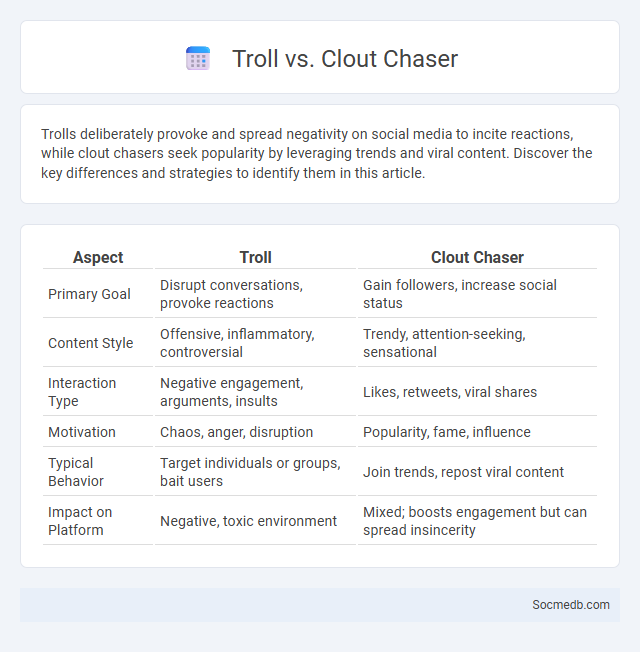
Photo illustration: Troll vs Clout Chaser
Trolls deliberately provoke and spread negativity on social media to incite reactions, while clout chasers seek popularity by leveraging trends and viral content. Discover the key differences and strategies to identify them in this article.
Table of Comparison
| Aspect | Troll | Clout Chaser |
|---|---|---|
| Primary Goal | Disrupt conversations, provoke reactions | Gain followers, increase social status |
| Content Style | Offensive, inflammatory, controversial | Trendy, attention-seeking, sensational |
| Interaction Type | Negative engagement, arguments, insults | Likes, retweets, viral shares |
| Motivation | Chaos, anger, disruption | Popularity, fame, influence |
| Typical Behavior | Target individuals or groups, bait users | Join trends, repost viral content |
| Impact on Platform | Negative, toxic environment | Mixed; boosts engagement but can spread insincerity |
Understanding the Troll: Definition and Motivations
A social media troll is an individual who deliberately provokes, disrupts, or manipulates online conversations to elicit emotional responses or sow discord. Motivations behind trolling include seeking attention, expressing frustration, or influencing public opinion through inflammatory content. Recognizing trolling behavior helps maintain constructive digital environments and mitigates the spread of misinformation.
Clout Chaser Explained: What Drives Their Actions?
Clout chasers seek attention and social validation through constant activity on social media platforms like Instagram and TikTok, often prioritizing viral trends over genuine content. Their actions are driven by the desire to increase followers, likes, and shares, leveraging algorithms that favor high engagement. This behavior reflects a broader cultural emphasis on online influence and status as measures of personal success.
Key Differences Between Trolls and Clout Chasers
Trolls deliberately provoke and spread negativity online to incite reactions and disrupt conversations, often hiding behind anonymity. Clout chasers aggressively seek attention and social validation by posting sensational or controversial content to boost their online presence and followers. Understanding these key differences helps you recognize harmful behaviors versus attention-seeking motives within social media communities.
Psychological Roots: Why People Troll or Chase Clout
Social media trolling and clout chasing stem from deep psychological needs such as the desire for attention, validation, and a sense of control. Individuals engage in trolling to provoke emotional responses and assert dominance, often fueled by feelings of insecurity or anonymity. Chasing clout involves continuous self-promotion driven by social comparison and the pursuit of status within online communities.
Online Behavior Patterns: Troll vs Clout Chaser
Online behavior patterns vary significantly between trolls and clout chasers, with trolls primarily engaging in provocative, disruptive comments to incite conflict and chaos within social media communities. Clout chasers, in contrast, strategically post attention-seeking content designed to maximize likes, shares, and follower growth, often leveraging trending topics or controversies without genuine engagement. Understanding these distinct motivations helps platforms develop targeted moderation strategies to enhance user experience and reduce toxic interactions.
Social Media Impact: Influencers, Trolls, and Clout Chasers
Social media platforms amplify the power of influencers who shape trends and consumer behavior through authentic content and large followings. Trolls disrupt online communities by spreading negativity and misinformation, affecting Your mental health and digital experience. Clout chasers seek rapid popularity, often prioritizing viral content over meaningful engagement, influencing the quality of social media interactions.
Recognizing the Signs: Spotting Trolls and Clout Chasers
Recognizing the signs of trolls and clout chasers on social media involves identifying patterns such as provocative comments designed to incite conflict, repeated attempts to hijack conversations, and excessive self-promotion aimed at gaining followers. Trolls often use inflammatory language and personal attacks to disrupt online communities, while clout chasers frequently seek validation through attention-grabbing posts and alliances with popular influencers. Understanding these behaviors helps users maintain healthier digital environments and reduces the impact of toxic interactions on platforms like Twitter, Instagram, and TikTok.
Consequences: How Trolls and Clout Chasers Affect Online Communities
Trolls disrupt online communities by spreading misinformation, provoking conflicts, and creating hostile environments that discourage genuine engagement. Clout chasers prioritize viral popularity over authenticity, diluting content quality and fostering superficial interactions. You may find your online experience increasingly fragmented and less trustworthy as these behaviors undermine meaningful connections and community trust.
Tactics and Strategies: How Trolls and Clout Chasers Operate
Trolls exploit social media algorithms by spreading provocative content that triggers emotional reactions, increasing engagement and visibility. Clout chasers strategically post trending topics and collaborate with influencers to amplify their reach and follower count. Understanding these tactics helps you recognize manipulative behavior and maintain authentic interactions online.
Dealing with Trolls and Clout Chasers: Moderation and Prevention
Effective moderation tools and clear community guidelines are essential for dealing with trolls and clout chasers on social media platforms. You can protect your online space by implementing robust comment filtering, user reporting systems, and proactive content review to prevent toxic behavior and maintain a positive environment. Empowering moderators with AI-driven detection and swift enforcement actions minimizes disruptions and preserves authentic engagement.
 socmedb.com
socmedb.com